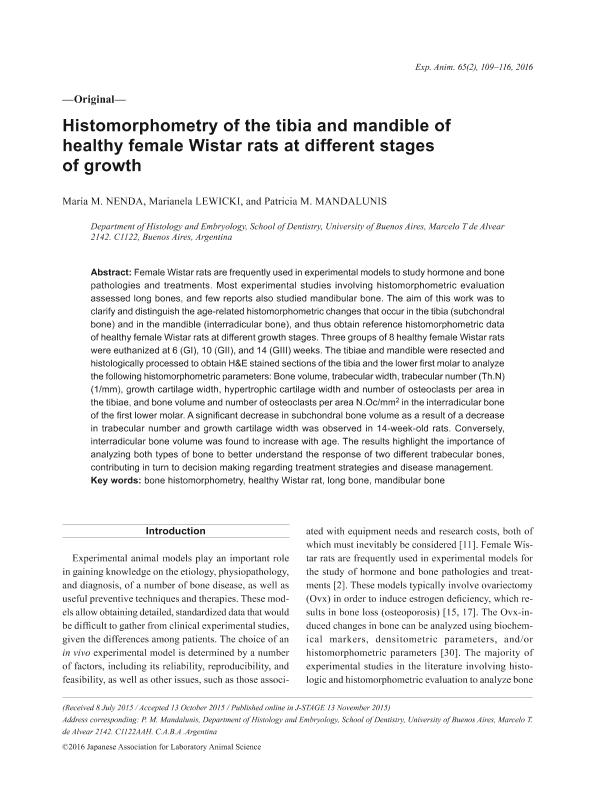Mostrar el registro sencillo del ítem
dc.contributor.author
Nenda, María M.
dc.contributor.author
Lewicki, Marianela

dc.contributor.author
Mandalunis, Patricia Mónica

dc.date.available
2018-03-19T21:50:10Z
dc.date.issued
2016-05
dc.identifier.citation
Nenda, María M.; Lewicki, Marianela; Mandalunis, Patricia Mónica; Histomorphometry of the tibia and mandible of healthy female wistar rats at different stages of growth; Japanese Association for Laboratory Animal Science; Experimental Animals; 65; 2; 5-2016; 109-116
dc.identifier.issn
1341-1357
dc.identifier.uri
http://hdl.handle.net/11336/39317
dc.description.abstract
Female Wistar rats are frequently used in experimental models to study hormone and bone pathologies and treatments. Most experimental studies involving histomorphometric evaluation assessed long bones, and few reports also studied mandibular bone. The aim of this work was to clarify and distinguish the age-related histomorphometric changes that occur in the tibia (subchondral bone) and in the mandible (interradicular bone), and thus obtain reference histomorphometric data of healthy female Wistar rats at different growth stages. Three groups of 8 healthy female Wistar rats were euthanized at 6 (GI), 10 (GII), and 14 (GIII) weeks. The tibiae and mandible were resected and histologically processed to obtain H&E stained sections of the tibia and the lower first molar to analyze the following histomorphometric parameters: Bone volume, trabecular width, trabecular number (Th.N) (1/mm), growth cartilage width, hypertrophic cartilage width and number of osteoclasts per area in the tibiae, and bone volume and number of osteoclasts per area N.Oc/mm2 in the interradicular bone of the first lower molar. A significant decrease in subchondral bone volume as a result of a decrease in trabecular number and growth cartilage width was observed in 14-week-old rats. Conversely, interradicular bone volume was found to increase with age. The results highlight the importance of analyzing both types of bone to better understand the response of two different trabecular bones, contributing in turn to decision making regarding treatment strategies and disease management.
dc.format
application/pdf
dc.language.iso
eng
dc.publisher
Japanese Association for Laboratory Animal Science
dc.rights
info:eu-repo/semantics/openAccess
dc.rights.uri
https://creativecommons.org/licenses/by-nc-sa/2.5/ar/
dc.subject
Bone Histomorphometry
dc.subject
Healthy Wistar Rat
dc.subject
Long Bone
dc.subject
Mandibular Bone
dc.subject.classification
Otras Ciencias Biológicas

dc.subject.classification
Ciencias Biológicas

dc.subject.classification
CIENCIAS NATURALES Y EXACTAS

dc.title
Histomorphometry of the tibia and mandible of healthy female wistar rats at different stages of growth
dc.type
info:eu-repo/semantics/article
dc.type
info:ar-repo/semantics/artículo
dc.type
info:eu-repo/semantics/publishedVersion
dc.date.updated
2018-03-15T14:10:01Z
dc.identifier.eissn
1881-7122
dc.journal.volume
65
dc.journal.number
2
dc.journal.pagination
109-116
dc.journal.pais
Japón

dc.description.fil
Fil: Nenda, María M.. Universidad de Buenos Aires. Facultad de Odontología. Cátedra de Histología y Embriología; Argentina
dc.description.fil
Fil: Lewicki, Marianela. Universidad de Buenos Aires. Facultad de Odontología. Cátedra de Histología y Embriología; Argentina. Consejo Nacional de Investigaciones Científicas y Técnicas. Oficina de Coordinación Administrativa Houssay. Instituto de Investigaciones en Microbiología y Parasitología Médica. Universidad de Buenos Aires. Facultad de Medicina. Instituto de Investigaciones en Microbiología y Parasitología Médica; Argentina
dc.description.fil
Fil: Mandalunis, Patricia Mónica. Universidad de Buenos Aires. Facultad de Odontología. Cátedra de Histología y Embriología; Argentina. Consejo Nacional de Investigaciones Científicas y Técnicas; Argentina
dc.journal.title
Experimental Animals

dc.relation.alternativeid
info:eu-repo/semantics/altIdentifier/url/www.jstage.jst.go.jp/article/expanim/65/2/65_15-0069/_article
dc.relation.alternativeid
info:eu-repo/semantics/altIdentifier/doi/http://dx.doi.org/10.1538/expanim.15-0069
dc.relation.alternativeid
info:eu-repo/semantics/altIdentifier/url/https://www.ncbi.nlm.nih.gov/pmc/articles/PMC4873479/
Archivos asociados
